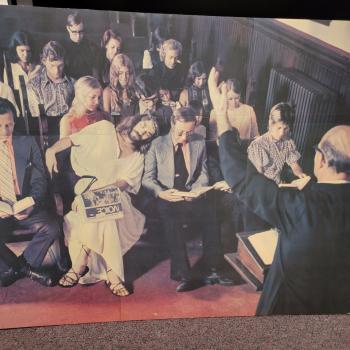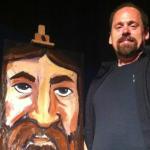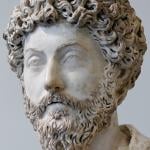LAZARUS COME OUT!—- John 11
A Message Preached Feb. 18th 2018— Southern Hills UMC, Lexington Ky.
Jesus shouted at a tomb containing a dead man— Lazarus come out. Very few have noted what an odd thing this is. I bet none of you have ever seen someone standing in a graveyard shouting something like this. But it reflects something important about Jesus who said he was the resurrection and the life, but also about how much he cared about Lazarus.
It will be good to take a long running jump into this text by considering some contextual issues first. This Gospel is unique, and among other things it has a unique four part structure— a prologue (‘in the beginning was the word…’) an epilogue (John 21— breakfast by the sea), and two major sections-the Book of Signs, and the Book of Glory, with the two parts connected by references to ‘the one whom Jesus loved’— namely Lazarus. While we are clearing things up his actual name is Eliezer, which got anglicized as Lazarus, and he is surely a different person than the only named person in any of Jesus’ Synoptic parables-the rich man and Lazarus. The Lazarus in John 11ff. is not a poor beggar, and he not only dies but rises in the story. And again, Eliezer was a common Jewish name (see both the OT and the Maccabees).
Notice that there is a crescendo of miraculous signs in John 2-11, climaxing with the raising of Lazarus. It is the seventh such sign, after which there are no more miracle tales, until the similar story occurs about Jesus himself— he is raised from a rock cut tomb as well, just like Lazarus. In other words, these two portions of the Gospel are very carefully crafted and structured to show the parallels between the climactic story of Lazarus, which is viewed as the straw that broke the camel’s back, and caused the authorities to decide they must do away with Jesus (and Lazarus), and the true climax of the Gospel in the raising of Jesus at the end of the book of glory in John 20. Seven, of course was the Jewish number for perfection, and so the raising of Lazarus not only completes the sign narrative accounts perfectly, it perfectly foreshadows the ultimate miracle— the raising of a crucified Jesus.
But why, especially since the other Gospel writers say nothing at all about Lazarus, even when Luke mentions Jesus visiting Mary and Martha in Lk. 10.38-42), why is a story about Lazarus the ultimately sign narrative that climaxes the first half of this Gospel? I would say it’s so important because Lazarus is indeed the one whom Jesus loved, as John 11.1-6 makes clear, thereafter called the Beloved Disciple, and he actually is the eye witness source of this material in the Fourth Gospel. This Gospel is distinct from the other three precisely because it tells the story of Jesus largely from a Judean perspective, tells the story through the eyes of Lazarus, and let’s be clear— if Jesus raised you from the dead, it would change your perspective on Jesus and everything else as well, I’d wager. This Gospel tells the story of Jesus seeing it through Easter eyes.
Before looking at some of the particulars of this great story a few more contextual things must be dealt with. First, Jews who believed in resurrection believed in a group resurrection of the righteous ‘on the last day’ as Martha herself says in this story. They were not looking for either a crucified or a raised messiah, an isolated resurrection of an individual in the midst of human history. No one, not even most of Jesus’ disciples looked for or expected that, despite Jesus’ intimations it would happen. Crucified messiah was as much an oxymoron for early Jews as Microsoft Works is for us. Secondly, many early Jews believed that the spirit of the deceased stayed with the body for only 2-3 days. After that it departed. There was no hope of a return. Thus Martha’s reaction to Jesus’ command to roll back the stone is perfectly understandable– there was no point. The spirit of Lazarus had departed his body, and there was only a stinking corpse in the tomb, or as the ancient KJV has Martha put it— ‘Lord he stinketh!’
Thirdly, the word sleep was used by early Jews who did believe in resurrection not to describe the condition of the dead, as though they were snoozing in the afterlife. Jews didn’t believe in that, so when Jesus says ‘Lazarus is sleeping’ he means his condition is no more permanent than that of a sleeping person. He will awaken from the condition refreshed and renewed. Lastly, notice how Martha with a not so subtle accusation -‘if you had been here, my brother would not have died’ believes in Jesus and in resurrection but inadequately. She doesn’t understand that Jesus IS the resurrection. People who come in contact with him can receive everlasting life or be raised from the dead immediately, not merely on judgment day. Just as there is a crescendo of the miraculous in this Gospel, climaxing with John 20, so there is also a climax of confessions in this Gospel, climaxing with Thomas’s ‘my Lord and my God’ which finally matches up with the confession in John 1 that says the pre-existent Son of God is God the Son.
So much for the ground clearing exercise. Let’s focus on who this Beloved Disciple is. There are many clues both in what is absent from this Gospel and what is present. To start with, there are no sons of Zebedee references in this Gospel except in the Epilogue in John 21. There is no calling of the Zebedees by the lake, no story about their presence at the raising of Jairus’ daughter, no story about their presence on the Mount of Transfiguration, no story about them asking Jesus for the box seats in the Kingdom. This is very odd if this Gospel is supposed to be the personal, eyewitness testimony of John son of Zebedee, and let me just say that the first time anyone seems to have claimed he wrote this is between the middle and end of the second century in the persons of Justin Martyr and then Irenaeus. The labels at the beginning of the Gospels are later additions to these documents, not part of the inspired text of the document itself. Nevertheless, I think there is a John who collected these eyewitness accounts and edited them and gave them to us all as a biography of Jesus— his name is John of Patmos, a member of the church in Ephesus, and the person who was exiled to Patmos and had those remarkable visions recorded in Revelation. He is not John son of Zebedee, who seems to have been martyred early in the first century like his brother, and just as Jesus himself said they would be (‘you will be baptized with the same baptism as I will undergo’).
Scholars today have increasingly recognized that the Fourth Gospel is the testimony of a Judean disciple, whether or not it is by Lazarus, for it has none of the famous Galilean miracle tales found in the Synoptics, apart from the feeding of the 5,000/walking on water tandem. That is the only Galilean miracle found in all four Gospels. Uniquely in this Gospel we hear about the healing of a paralytic, but where— at the pool of Bethesda in Jerusalem. Uniquely we hear in this Gospel about the healing of a man born blind, but where— at the pool of Siloam in Jerusalem, and of course we have the unique raising of Lazarus in Bethany, a suburb of Jerusalem. We have no exorcisms in this Gospel and no proper parables, two things that absolutely dot the landscape in the three earlier Gospels. Instead we have seven I am sayings, seven discourses (e.g. ‘I am the bread of life’), and seven sign narratives— mighty miracle stories ranging from turning water into gallons of Gallo, to raising Lazarus from the dead.
The references to the Beloved Disciple only begin in John 11, and continue then all the way to John 21. Lazarus is the bridge figure that links the Book of Signs and the Book of Glory. So, for instance we find Jesus reclining at table in Bethany in John 12. One wonders what they talked about ‘What was it like on the other side of the afterlife— did you see a bright light etc.’ One wonders what questions Peter asked Lazarus at that dinner. It is also at that dinner that Mary, as an act of gratitude, anoints Jesus’ feet. This is the same story we find in Mark 14, which is said to take place at the house of Simon the leper.
Here we may have an aha moment! Let us say Simon is the father of Mary, Martha, and Lazarus, and that he did indeed die of Hanson’s disease. This would immediately set off alarms in the Jewish community there about contagious diseases, and this may explain not only why Mary, Martha, and Lazarus are still single, living together as adults, and perhaps also Lazarus succumbed at a too early age to the same disease. In any case, John l1 told us that Jesus raised ‘the one whom he loved’ from the dead (the only person in this whole Gospel about whom that is said-that Jesus loved him in particular), John 12 has the celebratory response in their house, and then in John 13 we hear about the famous footwashing story, and again Jesus reclines with the Beloved Disciple. The normal dining protocol is that the chief guest reclines on the same couch with the host— in this case the Beloved Disciple. So both those meals are early during Passover week and in the house of Lazarus.
Let us then move forward to the story of Jesus’ capture, but we must bear in mind that John 11 told us that ‘the Jews’ that is the Jewish authorities from Jerusalem had attended the mourning of Lazarus, and were present when Jesus arrived four days late. They knew Lazarus quite well. This then explains not only why we get the personal name of the high priest’s slave, Malchus, whose ear Jesus healed at his capture, an ear severed by Peter, but also how the Beloved Disciple was able to waltz right into the high priest’s house, while Peter had to stand out in the courtyard warming his hands. The Beloved Disciple was not an unknown Galilean follower of Jesus like Peter. He was a Judean follower of Jesus, namely Lazarus.
Fast forward again to the crucifixion. There is the Beloved Disciple at the foot of the cross, receiving Jesus last will and testimony. The Synoptics tell us the Twelve were nowhere to be found. Judas had betrayed Jesus and hung himself. Peter had denied Jesus 3 times and like the others had hid or fled. But not the Beloved Disciple. He’s right there to the bitter end with Jesus. He is not a member of the Twelve, he is Lazarus, to whom Jesus bequeathed his mother. This why, according to Acts 1.14 Mary is still in Jerusalem awaiting Pentecost. She is staying in Bethany with Lazarus and family.
Fast forward again to John 20. Mary Magdalene reports Jesus has arisen and she has seen him alive and has commissioned her— she preaches the first Easter sermon. Peter and the Beloved Disciple race to the tomb, but the Beloved Disciple knows just where it is, and gets there first. Peter is puzzled by the empty tomb, but not the Beloved Disciple. Indeed, John 20 says ‘he saw the rolled up grave clothes and the empty tomb and believed, even though they did not know yet from the Scriptures Jesus must rise from the dead’. He had seen this movie before, indeed he had experienced it. God had raised Jesus just as God had raised the Beloved Disciple himself. Lazarus knew from experience, not from Scripture, what had happened.
Finally, fast forward to John 21. Here we learn that the BD had written down his memoirs and that after Jesus told Peter he would be martyred one day, Peter had asked what about the BD, and Jesus replied, ‘if it is my will he live until I return, what is that to you— follow me’. But then we have the disclaimer by the editor— Jesus did not say the BD would live until the second coming, it was a conditional statement. But one can understand why the BD’s community might think he would do so— after all, Jesus had already raised him from the dead once. They may have thought he would surely not die again. I’m not an archaeologist, nor do I play one on TV, but I would love to find Lazarus’ tombstone— it would say ‘died 29 A.,D., and then died, 90 A.D.’. That would confuse some people!
The end of John 21 tells us that the Johannine community had gathered the BDs written testimony, edited it, and made it available to us all— ‘this is the testimony of the BD and we know his testimony is true’. This is surely the voice of the final editor— John, returned from exile, and the one who shaped this Gospel into the form we have it now.
The Fourth Gospel is an eyewitness testimony of the leader of the Judean disciples of Jesus, just as Peter and his testimony as the leader of the Twelve Galileans is found in the Synoptics. We now can say with a high degree of likelihood we know who this Beloved Disciple actually was— not John son of Zebedee, or any other John, but rather Lazarus— ‘the one whom Jesus loved’.
Amen

















